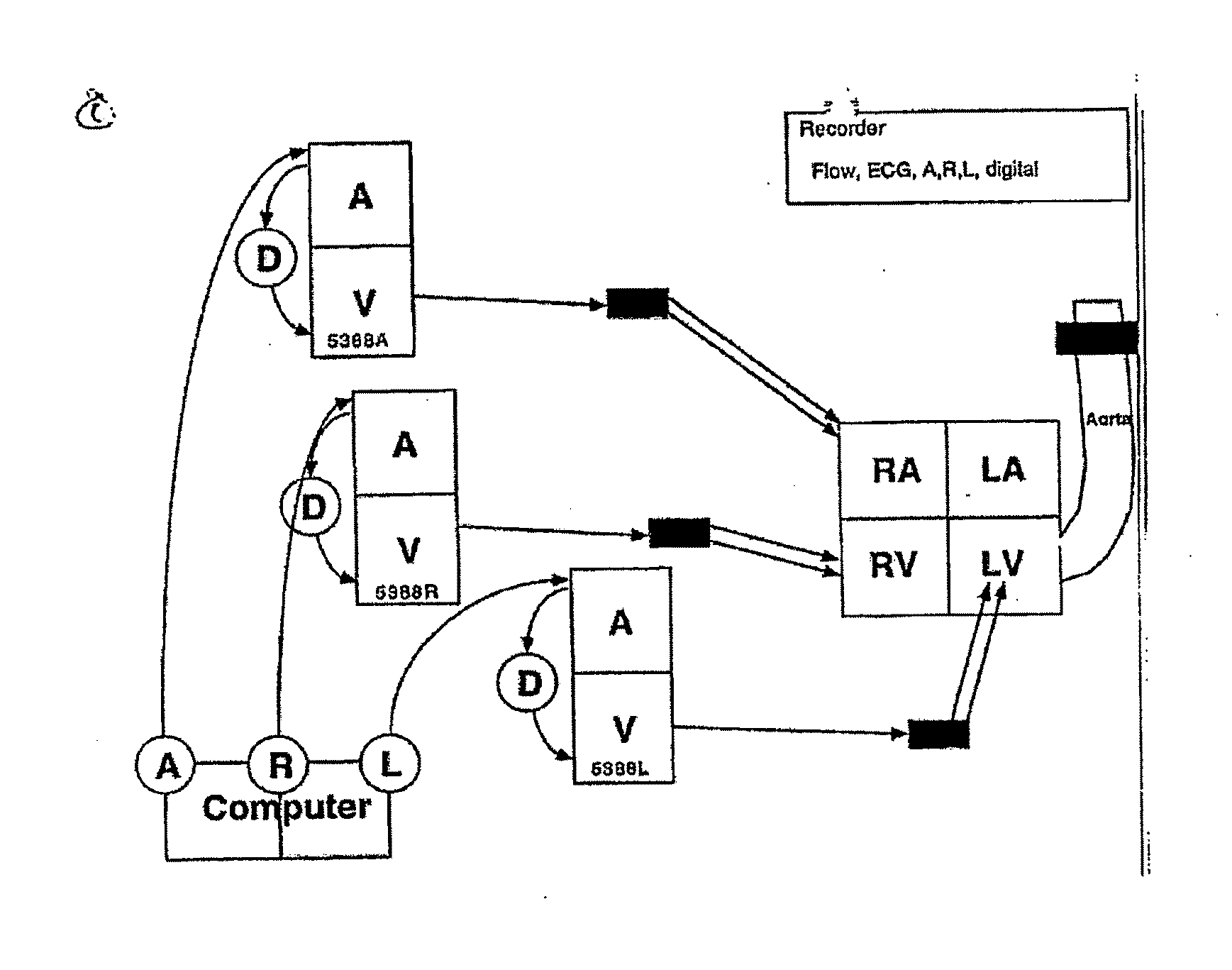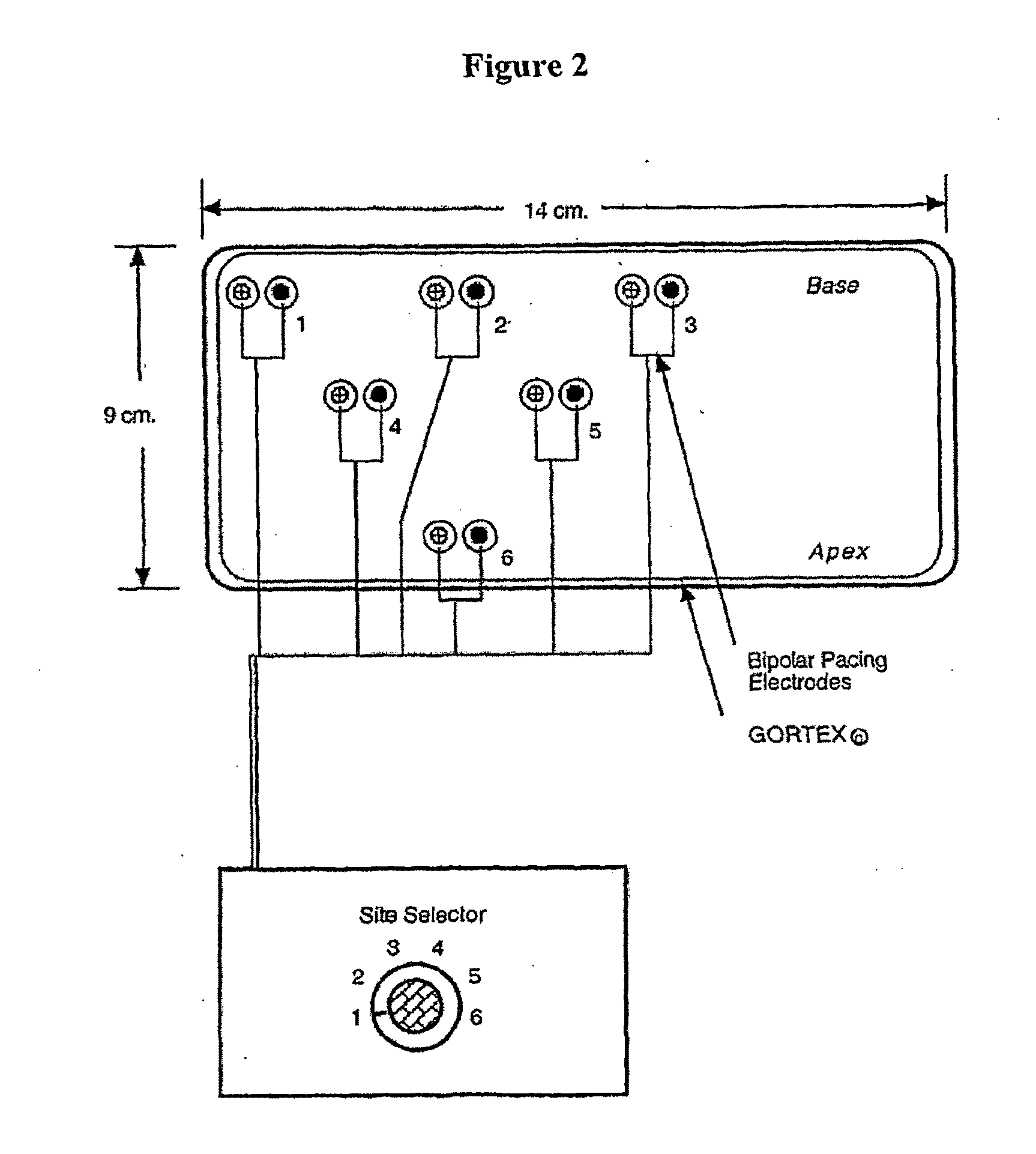Methods for optimization of biventricular pacing devices and systems useful therefor
a biventricular pacing and optimization method technology, applied in electrotherapy, heart stimulators, therapy, etc., can solve the problems of mechanical effects, slow roving leads, impracticality of multiple lvps testing with temporary wires, etc., to optimize biventricular pacing, optimize biventricular pacing, and improve cardiac output
- Summary
- Abstract
- Description
- Claims
- Application Information
AI Technical Summary
Benefits of technology
Problems solved by technology
Method used
Image
Examples
example 1
Optimized Biventricular Pacing in Atrioventricular Block After Cardiac Surgery
[0125]Temporary perioperative cardiac pacing is often required after open-heart surgery for treatment of sinus bradycardia and transient heart block. The effect of temporary perioperative cardiac pacing on cardiac output (CO) and stroke volume is rarely measured despite parameters that might be manipulated to the patient's advantage including heart rate (HR), ventricular pacing site (VPS), and atrioventricular delay (AVD). Use of ultrasonic transit-time aortic flow probes makes measurement of CO and stroke volume during implementation of temporary perioperative cardiac pacing more feasible. Atrioventricular delay and ventricular pacing site can be manipulated to increase cardiac output. By optimizing both atrioventricular delay and ventricular pacing site a 10% improvement in cardiac output would be observed compared to a standard pacing protocol. Seven patients in first or third degree heart block after v...
example 2
Optimized Perioperative Biventricular Pacing
[0142]Experimental data suggest that BiVP increases SV with no increase in myocardial oxygen consumption (MVO2). Stroke volume (SV) was measured by echo-Doppler in a substudy of the InSync III trial. Optimization of right-left delay (RLD), the delay between electrical stimulation of the right ventricle (RV) and LV in BiVP, increased SV 12% vs. no pacing (NoP), while standard BiVP with RLD=0 increased SV 5% vs. NoP. Experimental data suggest that BiVP increases SV with no increase in myocardial oxygen consumption (MVO2). Animal studies in our laboratory support the critical importance of RLD timing.
[0143]Optimized BiVP thus might be a valuable adjunct to the treatment of LVD or RV dysfunction (RVD) after cardiac surgery (open heart surgery, OHS) for acquired (AHD) or congenital (CHD) heart disease. Very little is known about BiVP in this setting. OHS frequently evokes ACHF, with perioperative requirements for beta agonists, phosphodiesteras...
example 3
Visualization of the Effect of Atrial-Ventricular and Right-Left Delay on Cardiac Output During Biventricular Pacing
[0209]Acute optimization of BiVP requires determining the appropriate atrial-ventricular delay (AVD) and right-left delay (RLD) on a patient-to-patient basis. This example examines the utility of CO surface plots for optimization of BiVP. In a study of pulmonary stenosis (PS) and tricuspid insufficiency (TI) in anesthetized pigs with induced heart block (HB), AVD and RLD were varied during BiVP and CO measured using an ultrasonic flow probe. Surface plots displaying CO with variations in AVD and RLD were generated. CO, represented by a red-to-blue color map (the vertical bar), is plotted against varying RLD (80 to −80 msec) on the abscissa and AVD (60 to 180 msec) on the ordinate and linearly interpolated between measured values. FIG. 22 shows representative CO surface plots during BiVP in a pig with pulmonary stenosis (left) and tricuspid insufficiency (right). (Note:...
PUM
 Login to View More
Login to View More Abstract
Description
Claims
Application Information
 Login to View More
Login to View More - R&D
- Intellectual Property
- Life Sciences
- Materials
- Tech Scout
- Unparalleled Data Quality
- Higher Quality Content
- 60% Fewer Hallucinations
Browse by: Latest US Patents, China's latest patents, Technical Efficacy Thesaurus, Application Domain, Technology Topic, Popular Technical Reports.
© 2025 PatSnap. All rights reserved.Legal|Privacy policy|Modern Slavery Act Transparency Statement|Sitemap|About US| Contact US: help@patsnap.com



